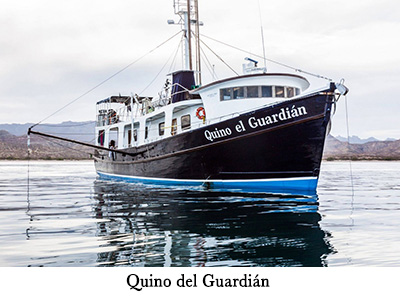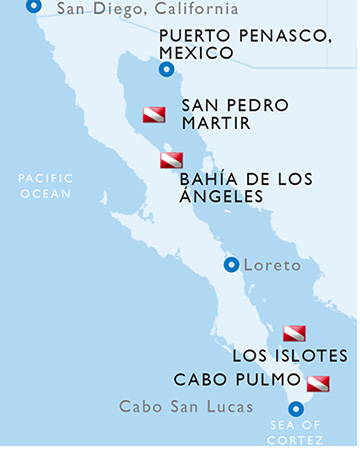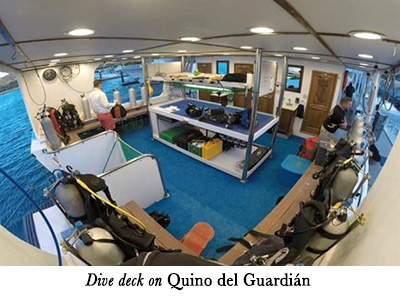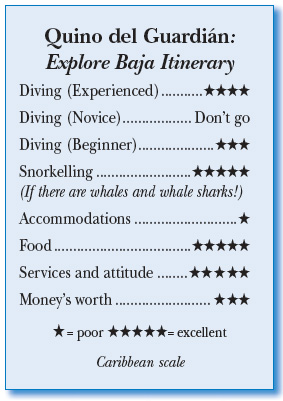Quino del Guardián, Sea of Cortés, MexicoContents of this Issue: Iberostar, Dressel Divers, Cozumel and Playa del Carmen Quino del Guardián, Sea of Cortés, Mexico Head/Mares Discovers the Reason for Full Face Mask Deaths A Row Erupts Over a Great White Shark’s Death Climate Change is Killing Clownfish The Rich Sounds of Healthy Reefs May Save Them Harrowing Tales from the Red Sea Aggressor I Fire Lithium-ion Battery Safety: Industry Experts Give Their Points of View U.S. Coast Guard Regulations under Criticism in Wake of the Conception Tragedy A Taste of the DEMA Show November 2019 Editorial Office: Ben Davison Publisher and Editor Undercurrent 3020 Bridgeway, Suite 102 Sausalito, CA 94965 great diving, but next time a better boat from the January, 2020 issue of Undercurrent
The Sea of Cortés is so isolated that many of its species are endemic. It is rich with life, with mollusk shells covering much of the sand, and the water is often so filled with juvenile fishes that they occlude the visibility. Diving its waters is like nothing else, with conditions ranging from high current, temperature swings and low visibility to crystal clarity and animals ranging from sea lions, unique jawfish, and rays, to whale sharks and sperm whales. In the fall, sister liveaboards the Quino del Guardián and Rocio Del Mar offer voyages along the entire length of the Sea. The landscape of Baja California is dazzling, starkly majestic, a reminder that there are still wild areas on our planet.
The first dive after departing Puerto Penasco, in the northern end, was Lolo's Cove, a murky site in the Midriff Islands that gave divers the chance to check their gear and weights. The water is more saline than most places, so I added a pound to compensate. Despite low visibility, I saw blue spotted jawfish popping up and down, Mexican hogfish, and Cortés angelfish. The other sites were more scenic. La Muela and Touched by an Angel had huge boulders with rubble and sand bottoms; photographers went nuts filming orange-throated pike blennies, cartoonish giant jawfish peering from their burrows, and dancing nuptial male blue spotted jawfish. I delighted in endemic fishes like Cortés and King angels, leopard grouper, and the abundant barberfish, members of the butterflyfish family. We 16 divers were divided into two groups of eight and dived from rigid-bottom inflatables (or pangas). Each group was accompanied by a dive guide and eagle-eyed panga captain. We were required to dive with a buddy, though this was honored in the breach sometimes, since this trip included lots of photographers who functioned effectively as solo divers. We were required to descend and ascend together, though my group included one diver who ascended early on almost every dive; guide Edgar accommodated him without interrupting the rest of us. The small, crowded dive deck boasts a big camera table with ample charging outlets. Most divers had cameras ranging from GoProstyle portables to massive devices the size of a tube television. The unusual nature of the trip attracted many Europeans, some conversing in breakneck Spanish with the all-Mexican crew, though many spoke English well. All of the crew were friendly, kind, and would happily help you in any way. They rotate between Quino and Rocio. The pangas pulled up on the transom and divers entered (carefully), clasping the arms of a crew member when conditions were rough. Most divers walked into the pangas wearing their gear, but others donned gear in the panga. At the dive's conclusion, you doffed your gear in-water, and the captain hauled it up. Each diver was required to carry an SMB and a whistle, and I carried a Dive Alert horn. Conditions are often rough, visibility can be low, currents strong, and crossings rough. I started Bonine two days before boarding and took it daily just to stay comfortable. Not at all a luxury boat, Quino is devoted to citizen science. She houses 16 divers in four-person bunk rooms below decks, with unusually narrow bunks. I wondered about the tightness of the quarters in an emergency. The crew demonstrated safety and exit procedures, and we performed a muster drill, but I was very aware of the sardine effect of packing all the divers into small bunks. The cabins have both fire extinguishers and smoke alarms, but since the California disaster, I am more aware than ever of fire safety. All divers were told to charge their batteries at the camera table; any bunk room charging could only happen while you were present and awake. The remoteness of Baja also encouraged us to dive safely; there is a chamber in San Jose del Cabo, which could mean a very long transit.
Though the shared bathrooms included hot showers, after every dive I used the deck shower and my dedicated deck towel. It was easier than bringing a change of clothes into the cramped bathroom. The bunks have comfortable mattresses that are unusually narrow -- about 22 inches -- though long. Turning over at night was nearly impossible. Folks wider than average had to sleep on their sides and try hard to ignore the loud noises emanating from the wooden hull while the boat was underway. Several divers chose to sleep on the padded benches in the salon and dining area to escape the noise. Requirement #2: be one of those folks who can sleep anywhere. Even earplugs were insufficient. I mention the discomforts not to disparage but to inform. It's not for everyone (this diver included) but it's just fine for many folks. I also praise its ethos of friendly service, excellent food, and the philanthropic efforts of its owners, Dora and Lolo Sandoval. They offer trips for teenagers from local fishing communities who are training in conservation, recognizing that local stakeholder involvement and opportunity will change lives and help save the Sea, which Jacques Cousteau once called "nature's aquarium" (www.heroesdelmar.org). No one leaves Quino weighing less! The outstanding meals by Chef Joshua came elegantly plated, with all dietary preferences quietly met. Though the dining area was simple and not very comfortable (like the rest of the boat), with padded benches on one side of each table and wooden benches on the other, no one left the table early. The food was too good. The crew laid out a hearty cold breakfast at 6 a.m., with yogurts, fruits, cereals, and breads. Hot breakfast followed the first dive and included omelets, eggs to order -- often with spicy Mexican sauces -- pancakes, waffles, sausage, bacon, and breakfast burritos. Every lunch began with hot soup, like veggie, lentil, or carrot, followed by stewed beef, build-your-own tacos, cheeseburgers with bacon, crispy fried fish fillets, and other hearty options. Most meals included guacamole, some form of beans, and bowls of homemade salsa. Dinner, which included very drinkable South American wines, was amazing. Tuna steaks with mango-kiwi salsa; huge shrimps wrapped in bacon; chicken breasts stuffed with spinach and cheese; the Yucatan Sunday delicacy, cochinita pibil (slow-roasted pork with tamarind and chiles); shrimp with chipotle cream sauce; steaks and meaty ribs -- and plenty of veggies. Good intentions crumbled when faced with Chef Joshua's desserts, from brownies to flan to apple crumble. Steward Flaco was happy to save your dessert to enjoy after the few night dives. Wine and beer were included, and those who enjoyed stiffer spirits brought their own. One of the highlights is the chance to snorkel with whale sharks in the Bahia de los Angeles, part of the Mexican national park system. The bay is replete with whale sharks -- it might take an hour to find one, but our captain found several in just minutes. I had a peak experience, gliding gently next to the mighty fish's eye as it sucked in food. I watched the working of its gills and admired the interior architecture of its mouth (that's how close I was!) for a good eight minutes before "my" shark pulled away from me. It was magical.
We dived other sea lion colonies near Los Islotes, close to Espiritu Santo island. The anchovies or scad were so thick that I sometimes could not see my buddy through the silver curtain. No wonder the sea lions were happy! Their antics were so amusing that I paid little attention to the schools of grunts, the five yellowfin tuna streaking by, and the massive yellowfin surgeonfish. Some sea lions were a tad aggressive, and I backed off when I saw their impressive teeth as they wrestled each other. I watched one diver offer his hand to a curious pup, and thought how annoyed I'd be if we had to divert to a hospital to have his mauled hand repaired. As the boat made its way south, often in rough seas, the water warmed up to the low 80s and there seemed to be more big animals. At El Arco near San Idelfonso island, I counted 14 massive green morays amidst the rock formations of cracks, canyons, defiles, and nooks. The eponymous arch was festooned with sea fans that sparkled in the light. We did one of our few night dives here, and I was reminded of how dense the life was by the numerous (and somewhat revolting) bloodworms attracted to our lights. After ascending, we were treated to a night sky devoid of light pollution and filled with stars. The Milky Way streaked across the center, made brighter by the barely-there crescent moon. We made a mid-journey stop at the small town of Loreto for about six hours to re-provision. Most divers leaped on shore, checked email and phones, and took walks. The lovely church, dating from the mid-1700s, was the first of the Franciscan missions on the Camino Real.
There were several wreck dives on the itinerary. The C54 Augustin Melgar near Danzante island had too much silt and not enough life. The ferry Salvatierra, near Espiritu Santo island, is more like a wreck of a wreck, scattered across a wide swath of sand bottom. I saw lots of schooling fish, including three handsome gafftopsail pompano, and a bunch of massive ancient green morays with cloudy eyes and often missing teeth! Near the end of the trip, we had a once-in-a-lifetime encounter. A pod of six sperm whales was transiting on the surface, five adults and one newly born calf. When the cry went up, there was some mayhem (one exhausted napping diver didn't even hear the call), and most piled into the pangas with snorkel gear. After several careful passes, we could see their massive foreheads, reminding me of the cover of Moby Dick. The staff said in all their years, this was the first close-up of sperm whales. For most on board, that encounter repaid most of the discomforts of the boat. The final dives in the Cabo Pulmo national park couldn't touch the whale experience. Super low vis and fussy rules made these dives forgettable, though a later group from our boat was treated to a parade of bull sharks. Still, I'll never forget the sea lions and mobulas, weird jawfish and blennies, great food, rough seas, and sleep deprivation. It was the best of times and sometimes the worst, but never dull. Next time, it's the Rocio del Mar for me. -- A.E.L. About the author: A.E.L. has dived all over the world, written for Undercurrent for over 10 years, and is a devoted citizen scientist. A.E.L. has made nearly 3500 dives, with over 65 liveaboard trips. Upcoming trips include the Solomon Islands and Bali, as well as Bonaire, where A.E.L. has lived part-time since 1997.
|

I want to get all the stories! Tell me how I can become an Undercurrent Online Member and get online access to all the articles of Undercurrent as well as thousands of first hand reports on dive operations world-wide
| Home | Online Members Area | My Account |
Login
|
Join
|
| Travel Index |
Dive Resort & Liveaboard Reviews
|
Featured Reports
|
Recent
Issues
|
Back Issues
|
|
Dive Gear
Index
|
Health/Safety Index
|
Environment & Misc.
Index
|
Seasonal Planner
|
Blogs
|
Free Articles
|
Book Picks
|
News
|
|
Special Offers
|
RSS
|
FAQ
|
About Us
|
Contact Us
|
Links
|
3020 Bridgeway, Ste 102, Sausalito, Ca 94965
All rights reserved.

 I spent 13 days aboard the Quino del Guardián, a 90-foot converted scallop fishing boat (the sibling of Rocio Del Mar), named for the owner's grandson Joaquin. Like every sibling, these vessels are clearly related but not the same. Having been on both, I know they have fantastic service, great food, and exciting diving. But Quino lacks its sibling's comforts. Living on it is more like camping than having the more upscale experience of Rocio. As one blunt New Yorker on my Explore Baja trip put it, "great service, great food, fun diving, but the boat sucks." More about that later.
I spent 13 days aboard the Quino del Guardián, a 90-foot converted scallop fishing boat (the sibling of Rocio Del Mar), named for the owner's grandson Joaquin. Like every sibling, these vessels are clearly related but not the same. Having been on both, I know they have fantastic service, great food, and exciting diving. But Quino lacks its sibling's comforts. Living on it is more like camping than having the more upscale experience of Rocio. As one blunt New Yorker on my Explore Baja trip put it, "great service, great food, fun diving, but the boat sucks." More about that later. Everyone, even the crew, shares four bathrooms
and two sinks on the main deck. So, to empty your
bladder at night, you had to climb the stairs, walk
through the small salon, step outside onto a wet
and pitching deck, and then pull yourself along the
brightly lit deck. Requirement #1 for a comfortable
Quino diver: a capacious bladder!
Everyone, even the crew, shares four bathrooms
and two sinks on the main deck. So, to empty your
bladder at night, you had to climb the stairs, walk
through the small salon, step outside onto a wet
and pitching deck, and then pull yourself along the
brightly lit deck. Requirement #1 for a comfortable
Quino diver: a capacious bladder! As the boat moved south, we approached San Pedro Martir Island, and the diving changed from the sublime to the comical -- at Arroyo, the stunning underwater boulders were awe-inspiring, like blocks carelessly strewn by giants. And then the sea lions showed up, spinning and blowing bubbles, behaving like naughty puppies. I laughed so hard that I flooded my mask! I barely noticed two massive green turtles puttering along. Subsequent dives featured more sea lions buzzing divers, sometimes nipping on a fin, and blowing bubbles in divers' faces. I saw more turtles, finescale triggerfish (similar to ocean triggers), longnose pufferfish following divers, lots of scorpionfishes, and many leopard groupers. The water temps in the northern Sea of Cortés can be chilly, in the mid-upper 70s deeper, to around 81 on the surface.
As the boat moved south, we approached San Pedro Martir Island, and the diving changed from the sublime to the comical -- at Arroyo, the stunning underwater boulders were awe-inspiring, like blocks carelessly strewn by giants. And then the sea lions showed up, spinning and blowing bubbles, behaving like naughty puppies. I laughed so hard that I flooded my mask! I barely noticed two massive green turtles puttering along. Subsequent dives featured more sea lions buzzing divers, sometimes nipping on a fin, and blowing bubbles in divers' faces. I saw more turtles, finescale triggerfish (similar to ocean triggers), longnose pufferfish following divers, lots of scorpionfishes, and many leopard groupers. The water temps in the northern Sea of Cortés can be chilly, in the mid-upper 70s deeper, to around 81 on the surface. The dive sites around Coronado Island tended to be deeper, 75-99 feet. The underwater landscape at Cabeza de Gorila was dramatic, with steep walls and huge rocks, in coolish water 76-79°F) and the current quickly went from zero to freeway speed. On one drift dive the current was so intense that diveguide Edgar called the dive at 30 minutes. The next dive featured more manageable current, sea lions, green turtles, and mobula rays, which also were top billing for two night dives near Espiritu Sancto island. The guides put out a powerful light to attract them. Because there was a lot of life in the water, it was turbid (of course, that's why the rays came to feed), we entered without lights to keep the focus on the center, where squadrons of rays streaked in and out. I kept hearing Wagner's Ride of the Valkyries in my head as they poured in from the darkness to feed!
The dive sites around Coronado Island tended to be deeper, 75-99 feet. The underwater landscape at Cabeza de Gorila was dramatic, with steep walls and huge rocks, in coolish water 76-79°F) and the current quickly went from zero to freeway speed. On one drift dive the current was so intense that diveguide Edgar called the dive at 30 minutes. The next dive featured more manageable current, sea lions, green turtles, and mobula rays, which also were top billing for two night dives near Espiritu Sancto island. The guides put out a powerful light to attract them. Because there was a lot of life in the water, it was turbid (of course, that's why the rays came to feed), we entered without lights to keep the focus on the center, where squadrons of rays streaked in and out. I kept hearing Wagner's Ride of the Valkyries in my head as they poured in from the darkness to feed! Diver's compass: The Explore Baja itinerary goes for $3495/person for 13 days . . . One flies into either Phoenix or San Jose del Cabo, depending on whether the trip goes north or south. Transport from Phoenix to Puerto Penasco is easy with Head Out to Rocky Point's van, $95 one way. Since the van departs the PHX airport at 1 P.M., I arrived the night before and stayed at an airport hotel . . . Water temps varied from 74° in the north to 82° south, with frequent thermoclines. Most divers wore 3m suits and got cold; the women wore 5m and 7m suits with hoods and were fine . . . Nitrox is $120; tanks were aluminum 80s, with steel 100s available for a small fee. Rental gear had to be reserved in advance. Over 12 dive days, I did 30 dives; 2-4 per day was typical, depending on conditions. To see videos of my bunk,
Diver's compass: The Explore Baja itinerary goes for $3495/person for 13 days . . . One flies into either Phoenix or San Jose del Cabo, depending on whether the trip goes north or south. Transport from Phoenix to Puerto Penasco is easy with Head Out to Rocky Point's van, $95 one way. Since the van departs the PHX airport at 1 P.M., I arrived the night before and stayed at an airport hotel . . . Water temps varied from 74° in the north to 82° south, with frequent thermoclines. Most divers wore 3m suits and got cold; the women wore 5m and 7m suits with hoods and were fine . . . Nitrox is $120; tanks were aluminum 80s, with steel 100s available for a small fee. Rental gear had to be reserved in advance. Over 12 dive days, I did 30 dives; 2-4 per day was typical, depending on conditions. To see videos of my bunk,
